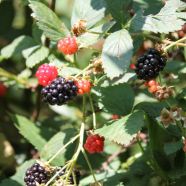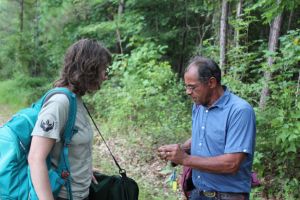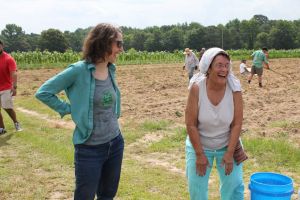Looking Back Can Help Forge Ahead: Ethnobotany and Indigenous Wisdom
Chronic diseases like hypertension, diabetes, and heart disease seem to forge onward despite ample Western medicine, public health campaigns, and expanding health budgets. Many people feel the frustration that the only thing growing faster than their waistline is their insurance premium, and, by the way, you still cannot get a good night’s sleep without a pill! Moreover, pathogens like viruses, bacteria, and fungi are relentlessly mutating and outwitting our increasingly hard-to-find discoveries.
Perhaps there is an overlooked tool—a forgotten tool that merges people, culture, and plants toward organic solutions that can mutate as fast as the pathogens. We are not calling for an abandonment of Western medicine, but perhaps our health problems have evolved to the point that our solutions must evolve with them. That’s why the work of ethnobotanists is so important.
The North Carolina Native American Ethnobotany Project is about understanding and documenting how Native American communities connect with plants on the most personal level—for survival, food, and medicine. This work incorporates the entire vibrant intersection of plants—including their life and chemistry. For decades, in typical capitalist tradition, Big Pharma has taken advantage of plant-based medicines by isolating biologically beneficial constituents and profiting monetarily by providing convenient pills to sell at a premium to patients. This model has never taken into consideration the full vim and vigor of indigenous medicine/herbalism’s holistic worldview of health; nor does it show respect for the plants or the integral synergistic properties contained within them.
Thanks to this project, our team has had many community site visits in the last nearly two years to the Coharie, Waccamaw Siouan, and Haliwa-Saponi tribes. Here is a smattering of some vignettes:
- Black walnut (Juglan nigra). Many tribal elders commented on the peculiar traits of this beautiful tree. Its ability to grow, by limiting other competing plants nearby, was noted by elders. In the “old days” many people would catch fish by blanketing small coves of fish with black walnut hulls. The toxin, called “juglone,” would then kill the fish, which could then be eaten. Furthermore, many community members recall their parents using the plant to treat ringworm. Preliminary Western science has found black walnut oil extracts may attack Pseudomonas aeruginosa, a common hospital pathogen, especially dangerous for people with weakened immune systems. Many elders laughed and reminisced too that one or two people in a community would often have large, productive black walnut trees in their yard. These people would be sought out at all times of the day and night in the fall nut season for these black walnut cures.
- American persimmon (Diospyros virginiana). Old timers waxed eloquently on this “prankster” tree, as everyone recalled “tricking” young friends into eating unripe/astringent fruits of these trees. These astringent tannins though, have proven useful in treating oral and pulmonary infections.
- Pine (Pinus). All Native American communities we interviewed had very personal stories about their relationships with the pine tree. The Waccamaw Siouan people recalled working on the Turpentine trail and recalled the multitude of uses for turpentine, while the Coharie and the Haliwa-Saponi recalled days of using pine needles for brewing beer and smoking meat.
Ethnobotany is the science of studying the relationship between humans and plants. In economic botany, these relationships are often based on how humans dominate plants and exhaust all potential economic utility, whether that use is medicinal, agricultural, or structural.
Yet, the relationship between people and plants is far deeper than profits and extends far beyond academic understanding. It is also about the laughter, stumbles, cuts, and exultant findings that occur when foraging. It is heirloom seeds and mason jars kept in cellars. It is proper identification via preservation in modern, climate-controlled university herbariums. It is about the proper preparation of the salve, tea, or the like and the failures that may occur as one learns these methods. Sometimes, it is being in the sunset years of life and being wistfully nostalgic, yearning for the days of mayapple jam while sipping iced tea or lemonade on grandma’s front porch. In essence, it’s about remembering, learning, and teaching all of these things.
Linwood Watson, a plant lover and practicing physician, lives in a world very different from an ethnobotanist’s perspective—the world of Western medicine. Western medicine is unparalleled in its ability to alleviate human suffering in certain situations. For example, if a bone is grossly dislocated, it is safely reset in a sterile orthopedic operating room. Or, if your loved one is having a stroke or heart attack, a great place to be is inside an American emergency room.
Western medicine has flexed its spectacular muscles on such “if a, then b” problems for the last 75 years or so. Nevertheless, there is a gaping hole in human health and suffering that Western medicine is helpless to address. We are witnessing this with the opioid addiction crisis and the climbing rates of suicides. Despite consuming ever more amounts of the US economy, American health is regressing. For the first time last year statistics showed that the average US lifespan is lessening, not growing. Even though many Americans are living longer, skyrocketing suicide rates indicate that our quality of life is regressing even more.
We believe that chronic diseases, or “lifestyle diseases,” are the Achilles heel of Western medicine. These are diseases where many times, we have met the enemy, and the enemy is ourselves. More specifically, our vices and/or our genetics are the enemy. Regardless, with most chronic diseases, it takes a partnership between patient and healer to forge a successful path forward. This path must be resilient, as it is assaulted daily by marketers. Patient passivity may ease the ability to sell pills, but passivity does not motivate one to remember to take a daily fluid pill for congestive heart failure, nor does it motivate one to go for a brief walk instead of having that second (or third) piece of pie.
This phenomenon is also why, despite 20 percent of Americans taking more than five daily prescription pills, so many people in so many clinics still look like the walking dead. They are alive, but only in wan, sallow terms of vital signs and blood chemistries. The bare numbers. What about the human spirit? Family dynamics? Or one’s ability to step outside of oneself long enough to see/feel/smell/touch/taste/pray with something not human? This is what the Native American Ethnobotany Project seeks to bring back to the human experience and we believe the world needs a little more of it.
When ethnobotanists talk about the power of elderberries and their antiviral properties, and how you should not eat them raw but rather how the fruit can be heated safely to become a syrup, we are offering the gateway to old-time healing. But, old-time healing is so much more than a syrup recipe. It is your children laughing at your purple-stained face as you pick the fruit. It is your husband smiling at you as you clumsily use a fork to “pick off” the tiny fruits without the woody filaments. It is the sadness of community members when they see the familiar fruits on the roadside but refrain from picking them for fear of roadside spraying or Gen X in the stream water.
Indeed it is life, and it is living life. This is what Indigenous people know. This is what ethnobotanists study. And it is what can hopefully partner with Western medicine for better lives—both human and plants. Is it possible that Western medicine has hit a plateau? Scientists are banking on genetic therapy to expand the Western medicine armamentarium, but we as patients are still the same human beings. Perhaps as humans we need something more, indeed some more wisdom. Plants have that wisdom. We just need to respectfully listen and feel the joy of belonging to a world of relations far beyond our human kin.
Note: Tracie Locklear, PhD, is a pharmacognosist/ethnobotanist and Linwood Watson, MD, is a family medicine physician. More information on the North Carolina Native American Ethnobotany Project can be found at www.ncnativeethnobotany.org. Please note that no part of this article constitutes medical advice; rather it is solely for informational purposes.












Well said Tracie! I will be using this article in.my classes
I know I speak for Tracie too Ila when I say a deep and sincere thank you for your support and walking the plant path well. With immense respect, Linwood Watson
This project is SO important. Congratulations, Tracie and Linwood and all the team for doing such a fantastic job. what a great contribution! with admiration, Nancy Turner